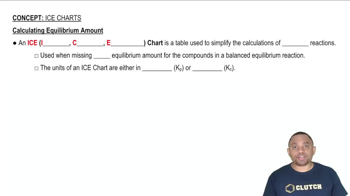Silver sulfate dissolves in water according to the reaction: Ag2SO4(s) ⇌ 2 Ag+(aq) + SO42-(aq) Kc = 1.1⨉10-5 at 298 K. A 1.5-L solution contains 6.55 g of dissolved silver sulfate. If additional solid silver sulfate is added to the solution, will it dissolve?

Consider the reaction and the associated equilibrium constant: aA(g) + bB(g) ⇌ cC(g) with Kc = 5.0. Find the equilibrium concentrations of A, B, and C for the given values of a, b, and c. Assume that the initial concentrations of A and B are each 1.0 M and that no product is present at the beginning of the reaction. Calculate the equations for x without solving them for the following cases: a) a=1, b=1, c=2; b) a=1, b=1, c=1; c) a=2, b=1, c=1.
 Verified step by step guidance
Verified step by step guidanceKey Concepts
Equilibrium Constant (Kc)

ICE Table

Stoichiometry

Consider the reaction and the associated equilibrium constant: aA(g) ⇌ bB(g) Kc = 4.0 Find the equilibrium concentrations of A and B for each value of a and b. Assume that the initial concentration of A in each case is 1.0 M and that no B is present at the beginning of the reaction. c. a=1;b=2
For the reaction shown here, Kc = 0.513 at 500 K. N2O4(g) ⇌ 2 NO2(g) If a reaction vessel initially contains an N2O4 concentration of 0.0500 M at 500 K, what are the equilibrium concentrations of N2O4 and NO2 at 500 K?
For the reaction shown here, Kc = 255 at 1000 K. CO(g) + Cl2(g) ⇌ COCl2(g) If a reaction mixture initially contains a CO concentration of 0.1500 M and a Cl2 concentration of 0.175 M at 1000 K, what are the equilibrium concentrations of CO, Cl2, and COCl2 at 1000 K?
